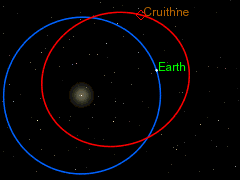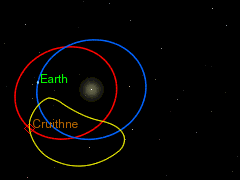3753 Cruithne
| 3753 Cruithne | |
(c) I, Sonia Keys, CC BY-SA 3.0 3753 Cruithne | |
| Upptäckt | |
|---|---|
| Upptäckare | J. D. Waldron |
| Upptäcktsplats | Siding Spring-observatoriet |
| Upptäcktsdatum | 10 oktober 1986 |
| Beteckningar | |
| MPC-beteckning | 3753 Cruithne |
| Alternativnamn | 1986 TO, 1983 UH |
| Uppkallad efter | Cruthin |
| Småplanetskategori | Aten-asteroid[1] |
| Omloppsbana[2] | |
| Epok: 21 januari 2022 | |
| Aphelium | 1,512 AU |
| Perihelium | 0,4839 AU |
| Halv storaxel | 0,9977 AU |
| Excentricitet | 0,5149801 |
| Siderisk omloppstid | 1,0 år |
| Medelomloppshastighet | 29,82 km/s |
| Medelanomali | 39,87° |
| Inklination | 19,81° |
| Longitud för uppstigande nod | 126,2° |
| Periheliumargument | 43,85° |
| MOID (Jorden) | 10 707 000 km |
| MOID (Mars) | 13 566 000 km |
| Fysikaliska data | |
| Dimensioner | ~5 km |
| Massa | 1,3×1014 kg |
| Medeldensitet | 2? g/cm³ |
| Synodisk rotationsperiod | 27,44 h |
| Albedo | 0,15 ? |
| Temperatur | ~275 K |
| Spektraltyp | Q |
| Absolut magnitud (H) | 15,59[2] |
3753 Cruithne eller 1986 TO är en asteroid i bana runt solen. Cruithne är en kvasisatellit till jorden, och kallas därför ibland "jordens andra måne". Den tillhör asteroidgruppen Aten.[1]
Upptäckt
Cruithne upptäcktes 10 oktober 1986 av astronomen Duncan Waldron vid Siding Spring-observatoriet, men det dröjde ända till 1997 innan den ovanliga banan upptäcktes och det var därför man till en början ansåg att Cruithne kunde vara ytterligare en måne till jorden. Asteroiden har fått sitt namn efter den iriska benämningen på pikterna.[3]
Storlek och bana


Cruithnes diameter är cirka 5 km. Anledningen till att man trodde att denna asteroid var en måne till jorden var den konstiga banan. Cruithne korsar jordens bana och det ser ut som att de följer efter varandra (se bild). Anledningen till detta är ganska enkel. Cruithne går i en vanlig bana runt Solen. Men då hastigheten är så lik Jordens, ser det ut som att de följer efter varandra.
Cruithne har väldigt låg magnitud och kräver ett stort spegelteleskop för att kunna ses. Detta gör den svårare att se än Pluto.
Referenser
- ^ [a b] ”List Of Aten Minor Planets (by designation)”. http://www.cfa.harvard.edu/iau/lists/Atens.html. Läst 1 november 2008.
- ^ [a b] Minor Planet Center Queries, uppdaterad 29 januari 2022.
- ^ ”Minor Planet Center 3753 Cruithne” (på engelska). Minor Planet Center. https://www.minorplanetcenter.net/db_search/show_object?object_id=3753. Läst 15 september 2018.
Externa länkar
- Diagram över omloppsbanan för 3753 Cruithne från NASA Jet Propulsion Laboratory (JPL)
| |||||||||||
Media som används på denna webbplats
Författare/Upphovsman: User:Jecowa, Licens: CC BY-SA 3.0
The orbits of Cruithne and Earth over the course of a year (from September 2007 to August 2008). Cruithne's location is indicated by the red box as it is too small to be seen at this distance. Earth is the white dot moving along the blue circle. The pale yellow circle in the centre is our Sun.
The blue circle represents the path of Earth as it revolves counter-clockwise around the sun. The "camera" revolves with Earth, so Earth appears to not be moving.
The red path represents the path that Cruithne takes as it revolves around the sun. Since the camera is rotating with Earth, Cruithne appears to move along a bean-shaped path. This illusion is known as a Horseshoe orbit.Författare/Upphovsman: Härlett verk: User:Jecowa, Licens: CC BY-SA 3.0
The orbits of Cruithne and Earth over the course of a year (from September 2007 to August 2008). Cruithne's location is indicated by the red box as it is too small to be seen at this distance. Earth is the white dot moving along the blue circle. The yellow circle in the centre is our Sun.



